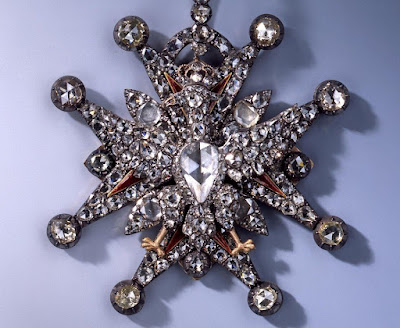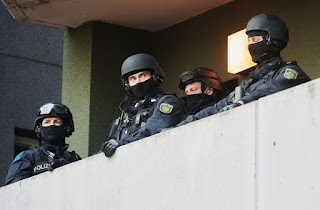Rooms in Dresden's historic building date back to the C16th. The unique and priceless jewel sets in Dresden Grünes Gewölbe-Green Vault were the Museum’s special attraction. Among the stolen pieces were the diamond jewellery of former Saxon queens, a military star of the Polish Order of the White Eagle and a stunning diamond-encrusted sword. These priceless items were acquired in 1723 by Augustus the Strong, Elector of Saxony and later king of Poland, who had a fierce rivalry with France’s King Louis XIV.
The jewels survived Allied bombing raids in WW2 but were apparently seized by Red Army soldiers as war booty. The precious jewels were returned to the Dresden Museum in 1958, and kept in display cases. Then there was extensive renovation and restoration work in 2006.
Even when the robbers’ escape appeared on security cameras, it was seen as too dangerous to chase after them. They set fire to a car in a nearby underground carpark, causing a million euros' worth of damage to the museum and car park. The robbers used fire extinguisher foam to cover their tracks and sped off quickly in their getaway car, a Mercedes disguised as a taxi, back to Berlin 10 mins after they entered the Museum. The insured value of the 4,300 jewels, in this the biggest heist in modern German history, was $135 million.
After a year-long investigation by 40 officers, 3 suspects were arrested after police raided 18 Berlin properties. Two brothers were caught in Dec 2020-Feb 2021, and the third suspect was arrested in summer 2021. Prosecutors are still investigating 40 others in relation to the heist, including four men who are suspected of entering the museum disguised as tourists. The fake tourists’ role was to gather strategic information about security, layout and personnel.
Some of the accused German nationals, aged in their mid 20s, will be tried in a juvenile court, as two of them were legally minors at the time of the heist. All of the accused were charged with being gang members involved in gang robbery and aggravated arson.
The jewels survived Allied bombing raids in WW2 but were apparently seized by Red Army soldiers as war booty. The precious jewels were returned to the Dresden Museum in 1958, and kept in display cases. Then there was extensive renovation and restoration work in 2006.
Dresden Grünes Gewölbe-Green Vault
beautiful displays behind glass windows, BBC
In Nov 2019 the Dresden robbers must have prepared, unnoticed, a week beforehand; they used a hydraulic bolt-cutter to slice a hole in a window-grate that they then glued together to disguise the break. The suspects set fire to a power distribution box near the Museum to plunge the streets and gardens into darkness before the break-in.
Several people entered the elaborate marble and mirror-clad room housing the jewels and quickly smashed a glass cabinet with an axe before leaning over to seize the items with fishing twine. The robbers sawed through iron bars to gain entry to the display room as seen by the security camera. The footage showed 2 men entering the room, waving their flashlights across the black-and-white-tiled floor. They then shattered a glass display case with an axe before grabbing the 21 pieces of diamond encrusted jewellery, armed with a loaded revolver and an automatic loading gun and silencer. The items included an epaulette, rapier, shoe buckles, hat pin, brooches, a Polish Order of the White Eagle gem, large diamond rose and several skirt buttons.
Brooches, top one displaying the Polish Order of the White Eagle
beautiful displays behind glass windows, BBC
In Nov 2019 the Dresden robbers must have prepared, unnoticed, a week beforehand; they used a hydraulic bolt-cutter to slice a hole in a window-grate that they then glued together to disguise the break. The suspects set fire to a power distribution box near the Museum to plunge the streets and gardens into darkness before the break-in.
Several people entered the elaborate marble and mirror-clad room housing the jewels and quickly smashed a glass cabinet with an axe before leaning over to seize the items with fishing twine. The robbers sawed through iron bars to gain entry to the display room as seen by the security camera. The footage showed 2 men entering the room, waving their flashlights across the black-and-white-tiled floor. They then shattered a glass display case with an axe before grabbing the 21 pieces of diamond encrusted jewellery, armed with a loaded revolver and an automatic loading gun and silencer. The items included an epaulette, rapier, shoe buckles, hat pin, brooches, a Polish Order of the White Eagle gem, large diamond rose and several skirt buttons.
BBC
After a year-long investigation by 40 officers, 3 suspects were arrested after police raided 18 Berlin properties. Two brothers were caught in Dec 2020-Feb 2021, and the third suspect was arrested in summer 2021. Prosecutors are still investigating 40 others in relation to the heist, including four men who are suspected of entering the museum disguised as tourists. The fake tourists’ role was to gather strategic information about security, layout and personnel.
Some of the accused German nationals, aged in their mid 20s, will be tried in a juvenile court, as two of them were legally minors at the time of the heist. All of the accused were charged with being gang members involved in gang robbery and aggravated arson.
Armed police officers are standing on a balcony during a raid in Berlin
November 2021, art net news
Trial
Two of the Green Vault suspects now on trial were already sentenced to 4.5 years in gaol for their 2017 involvement in the 100kg gold coin worth $4.22 million, stealing it from Berlin’s Bode Museum. This had been another crime that shook Germany.
The trial of six men started in Dresden’s district court amid tight security. The defendants, all brothers and cousins aged in their mid 20s, appeared in court, handcuffed and with face covers. Proceedings are being held in, until Oct, where the men sit behind security glass.
In accordance with German judicial practice, the defendants have been referred only by their surname’s initial, R. But police had said that the suspects were members of the Remmo Clan, a family infamous for its ties to organised crime, a Berlin clan consisting of 10 families. Four other men were under investigation on suspicion of aiding and abetting, in this crime.
Did the robbers have help from insiders at the museum? Evidence suggests the robbers were aware of parts of the museum that security cameras were unable to detect.
There is a realist fear that the art objects have been broken up so that the sale of individual diamonds could go ahead, undetected by the auction houses. Yet it is possible that publicity surrounding the trial could raise awareness among people in the diamond trade who might be invited to buy them. Authorities initially offered reward of $570,000 to anyone who would lead police to the jewellery’s whereabouts. That was later raised to $1.71 million, after a private initiative to collect donations. The defendants have so far refused to give answers.
November 2021, art net news
Trial
Two of the Green Vault suspects now on trial were already sentenced to 4.5 years in gaol for their 2017 involvement in the 100kg gold coin worth $4.22 million, stealing it from Berlin’s Bode Museum. This had been another crime that shook Germany.
The trial of six men started in Dresden’s district court amid tight security. The defendants, all brothers and cousins aged in their mid 20s, appeared in court, handcuffed and with face covers. Proceedings are being held in, until Oct, where the men sit behind security glass.
In accordance with German judicial practice, the defendants have been referred only by their surname’s initial, R. But police had said that the suspects were members of the Remmo Clan, a family infamous for its ties to organised crime, a Berlin clan consisting of 10 families. Four other men were under investigation on suspicion of aiding and abetting, in this crime.
Did the robbers have help from insiders at the museum? Evidence suggests the robbers were aware of parts of the museum that security cameras were unable to detect.
There is a realist fear that the art objects have been broken up so that the sale of individual diamonds could go ahead, undetected by the auction houses. Yet it is possible that publicity surrounding the trial could raise awareness among people in the diamond trade who might be invited to buy them. Authorities initially offered reward of $570,000 to anyone who would lead police to the jewellery’s whereabouts. That was later raised to $1.71 million, after a private initiative to collect donations. The defendants have so far refused to give answers.
The heist was described as the biggest in modern German history
so security at court had to be tight. DW
The trial, involving 14 defence lawyers from across Germany, three prosecutors and representatives of the juvenile court (because of the age of two twin brothers at the time of the crime), is expected to continue at least until late Oct. Read Daily Art Magazine
so security at court had to be tight. DW
The trial, involving 14 defence lawyers from across Germany, three prosecutors and representatives of the juvenile court (because of the age of two twin brothers at the time of the crime), is expected to continue at least until late Oct. Read Daily Art Magazine




